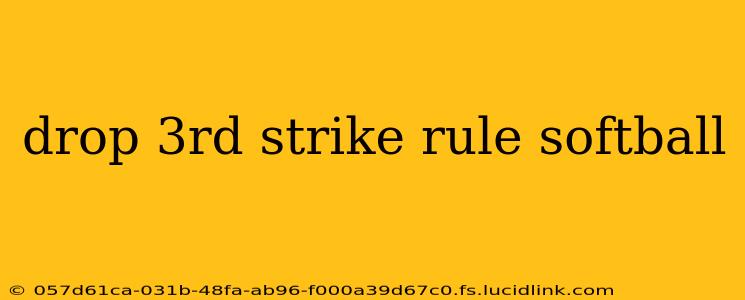Softball, a beloved sport enjoyed by millions, has its own set of rules that govern gameplay. One rule frequently misunderstood and debated is the "third strike rule," specifically concerning what happens after a batter receives three strikes. This comprehensive guide will clarify the intricacies of this rule, addressing common questions and misconceptions.
What Happens After Three Strikes in Softball?
In softball, as in baseball, three strikes generally result in the batter being "out." This means their at-bat is over, and they must leave the batter's box. However, there's a crucial nuance. The specific outcome depends on whether the third strike is caught by the catcher or not.
If the catcher catches the third strike:
The batter is automatically out. This is a straightforward application of the rule. The play is over, and the batting team loses an out.
If the catcher doesn't catch the third strike:
This is where things get more complex. If the third strike is not caught, the umpire will declare it a "dropped third strike." In this scenario, the batter is not automatically out. They are allowed to attempt to run to first base. If they reach first base safely before the defense can make a play to get them out (e.g., a throw to first), they become a runner on first base. If the defense tags them out before they reach the base, then they are out.
What are the strategic implications of a dropped third strike?
The dropped third strike rule adds a significant strategic element to the game. A dropped third strike presents an opportunity for the batter to reach base even after making what would traditionally be an out. This can completely change the dynamics of an inning, setting up scoring opportunities. It forces the defense to be alert and react quickly.
Is the dropped third strike rule the same in all softball leagues?
While the core principle remains consistent across most softball leagues (a dropped third strike allows the batter to run to first), there might be slight variations depending on the specific league's rules. It's always advisable to check the official rulebook of the league in question to confirm the exact implementation. Youth leagues, for example, may have slightly different interpretations or modifications.
How does the dropped third strike rule affect baserunning?
The dropped third strike rule directly impacts baserunning. If the batter becomes a runner on first, it creates a different baserunning situation than a traditional out. Other runners on base will now need to consider advancing based on the new position of the runner on first. This can lead to more aggressive baserunning strategies.
Can a dropped third strike lead to errors?
Yes, a dropped third strike can result in errors. If the catcher misses the third strike, and the batter safely reaches first, the defense might make further errors in trying to get the runner out. These errors are often recorded as fielding errors against the catcher or other defenders involved in the play.
What happens if a runner is on third base and the batter gets a dropped third strike?
With a runner on third and a dropped third strike resulting in a runner on first, the situation is ripe for a possible run. The runner on third will likely attempt to score on any play that isn't a force out at any of the bases. This emphasizes the importance of the defense's reaction time in this situation. A successful steal attempt or an error on the throw to first can allow the runner on third an easy path to home.
This comprehensive guide should clear up any confusion regarding the third strike rule in softball. Understanding this rule enhances the enjoyment and appreciation of the game, both for players and spectators alike. Remember to always refer to the specific rulebook of the league you are participating in for definitive answers.
